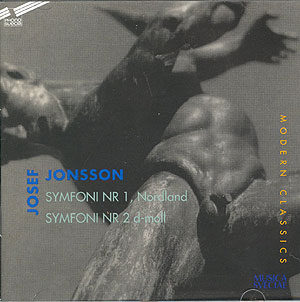Jonsson's
first two of three symphonies are here performed by the orchestra
of his home city. Norrköping was the scene of many of his
premieres and there he was guaranteed sustained attention. The
orchestra performed forty-four of his works of which twenty-six
were premieres. He wrote the programme notes for the orchestra's
concert seasons from 1905 onwards. In early childhood he contracted
polio and was lifelong confined to a wheelchair. Jonsson's style
was closer to the Schumann-Gade Germanic romanticism than to strong
Swedish nationalism-impressionism. Certainly when you compare
him with Pergament in the 1920s Jonsson's music is traditional
and romantically old-fashioned.
The
Nordland Symphony, while carrying bardic verses
as a superscription to each movement, stays firmly within the
bounds set by Schumann and Mendelssohn. He may perhaps be cast
as a Swedish Fibich. The Symphony is not without folksy atmosphere
and some rustically piping delicacy and playfulness in the inner
two movements. The finale plays for 20.30 and has some mood-parallels
with the sunset idylls of Louis Glass's Fifth Symphony - a much
stronger work with an assertive Tchaikovskian presence. The Delian
glow and fade is superbly sustained by Jonsson and links back to
the almost equally magical second movement. This is an expansive
late-romantic piece with its forebears in Raff but with winds
of change from Grieg and early Ludolf Nielsen.
The
First Symphony was premiered on 10 October 1923 by the Gothenburg
orchestra conducted by Ture Rangström. The work was given
its Stockholm premiere on 30 January 1924 conducted by his supporter
Kurt Atterberg. Atterberg greeted his Missa Solemnis (1936)
as ‘a Swedish masterpiece’.
The
Second Symphony was premiered at Norrköping conducted
by the then principal conductor Tard Brenner. Adolf Wiklund conducted
its first performance in Stockholm. This is a much less garrulous
work than the First. It still has the same Romantic DNA but ideas
are more concentrated - less rhapsodic-meandering. The work is
unusual in having three fast and energetic movements with the
only adagio marking being part of the middle movement. This music
reminded me a little of Stanford and Sullivan but the Schumann-Mendelssohn
mulch and folk origins are clear enough.
There
is also a Third Symphony, as yet unrecorded. That is his Op. 50
in C minor. It was premiered by none other than the Norrköping
Orchestra conducted by Heinz Freudenthal on 26 October 1947.
Jonsson
has even more personality in the garrulous First Symphony than
in the Second. This is certainly for you if you are partial to
Gade and Raff with a Scandinavian flavour.
Well
documented, performed and recorded symphonies written in an unflinchingly
late-romantic traditional style with Germanic forebears and a
light dusting of nationalistic flavour.
Rob
Barnett
